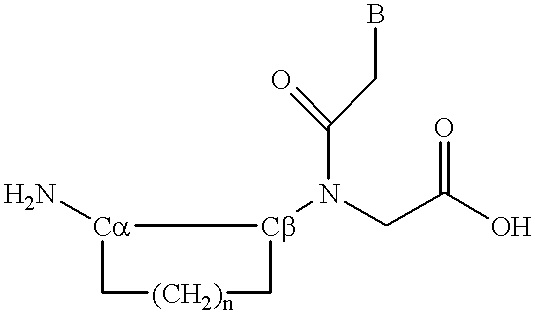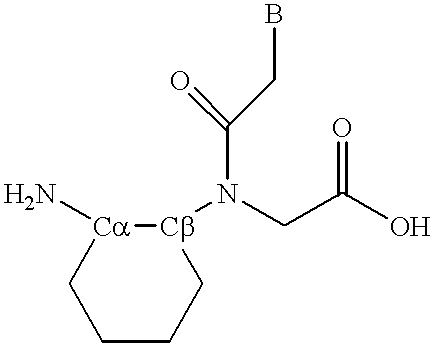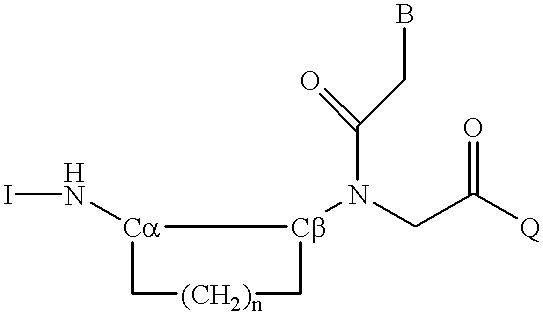Peptide nucleic acid incorporating a chiral backbone
a chiral backbone and peptide technology, applied in the field of peptide nucleic acid incorporating chiral backbones, can solve the problem of reducing binding specificity
- Summary
- Abstract
- Description
- Claims
- Application Information
AI Technical Summary
Benefits of technology
Problems solved by technology
Method used
Image
Examples
example 1
(1S,2S)-1-(N-t-butyloxycarbonylamino)-2-minocyclohexane (1)
To a cooled solution of (1S,2S)-diaminocyclohexane (5 ml; 41.6 mmol) in CH.sub.2 Cl.sub.2 (25 ml) was added a solution of di-t-butyl dicarbonate (3.03 g; 13.9 mmol) in CH.sub.2 Cl.sub.2 (25 ml) over a period of 30 mins. The reaction mixture was stirred overnight at room temperature. Water (20 ml) and CH.sub.2 Cl.sub.2 (25 ml) were added in order to dissolve the precipitate. After separation of the two phases, the organic phase was concentrated under reduced pressure and the residue was dissolved in ether (25 ml) and water (25 ml). The mixture was acidified to pH 5 with HCl 4 N and the bis-protected diamnine was extracted with ether (3.times.25 ml). The aqueous phase was adjusted to 10.5 with NAOH 2 N and extracted with ethylacetate (6.times.30 ml). The organic phase was dried over sodium sulfate, filtered and evaporated under reduced pressure to yield the title-compound (2.3 g, 73% based on Boc.sub.2 O).
MP:109-111.degree. C....
example 2
N-(2S-Boc-aminocyclohex-1S-yl)-glycine, methyl ester (2)
To a cooled suspension of 1 (2 g, 9.35 mmol) and potassium carbonate (3.87 g, 28.05 mnmol) in DMF (15 ml) was added a solution of methyl bromoacetate (0.9 ml, 9.35 mmol) in DMF (5 ml) over a period of 5 min. After one hour at 0.degree. C. the salts were filtered and washed with DMF and CH.sub.2 Cl.sub.2. The filtrate was evaporated under reduced pressure and the residue was purified by chromatography on silica gel (eluent ethylacetate). Yield: 1.9 g (70%).
mp:68-70.degree. C.; NMR.sup.1 H (dmso d6) ppm: 1.0-1.3 (m,4 H,2CH.sub.2 cycl); 1.45 (s, 9 H, t-Boc); 1.4-2.0 (m,5 H,2CH.sub.2 cycl+NH); 2.3 (dt, 1 H, CHN) ; 3.1 (m, 1 H, CHN) ; 3.4 (dt, 2 H, CH.sub.2 COO) ; 3.7 (s, 3 H, COOCH.sub.3); 6.7 (m, 1 H, NH carbamate); NMR .sup.13 C (dmso d6) ppm: 172.9 (ester); 155.5 (carbamate); 77.5 (t-Boc); 59.7, 47.6 (CH.sub.2 COOCH.sub.3); 53.7, 51.4, 32.1, 31.1, 24.6, 24.2 (C cycl); 28.3 (t-Boc); MSFAB+: 287.0 (M+1).
example 3
N-(2S-Boc-aminocyclohex-1S-yl)-N-(thymin-1-ylacetyl) -glycine, methyl ester (3)
To a solution of 2 (1.5 g, 5.24 mmol), thymine acetic acid (0.96 g; 5.22 mmol) and DhbtOH (0.85 g, 5.2 mmol) in DMF (15 ml) and CH.sub.2 Cl.sub.2 (15 ml) was added DCC (1.08 g, 5.24 mmol). After 4 hrs at room temperature, DCU was filtered and washed with CH.sub.2 Cl.sub.2 (100 ml). The filtrate was washed with NaHCO.sub.3 1 M (3.times.40 ml), KHSO.sub.4 1 M (2.times.40 ml), H.sub.2 O (40 ml). The organic phase was dried over sodium sulfate and filtered. Petroleum ether (100 ml) was added. After 48 h at 0.degree. C., the title compound was collected by filtration. Yield: 1.7 g (72%).
mp: 205-207.degree. C.; NMR .sup.1 H (dmso d6) ppm: 1.2-2.0 (m, CH.sub.2 cycl); 1.45 (s, t-Boc); 1.9 (CH.sub.3 thymine); 3.7 (S, COOCH.sub.3); 3.7 (dd, CH.sub.2 COO); 4.8 (dd, CH.sub.2 -T); 6.95 (m, NH carbamate); 7.2 (s, H-C.dbd.C-Me); 11.35 (s, NH imide); NMR .sup.13 C (dmso d6) ppm: 169.7, 167.1, 164.3, 154.9, 150.9 (C.dbd.O...
PUM
| Property | Measurement | Unit |
|---|---|---|
| Temperature | aaaaa | aaaaa |
| Structure | aaaaa | aaaaa |
Abstract
Description
Claims
Application Information
 Login to View More
Login to View More - R&D
- Intellectual Property
- Life Sciences
- Materials
- Tech Scout
- Unparalleled Data Quality
- Higher Quality Content
- 60% Fewer Hallucinations
Browse by: Latest US Patents, China's latest patents, Technical Efficacy Thesaurus, Application Domain, Technology Topic, Popular Technical Reports.
© 2025 PatSnap. All rights reserved.Legal|Privacy policy|Modern Slavery Act Transparency Statement|Sitemap|About US| Contact US: help@patsnap.com



